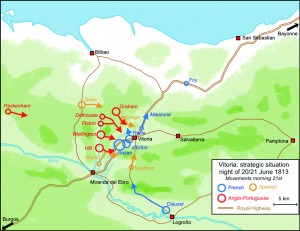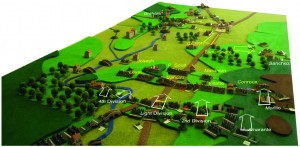The Dining Table Napoleon V3 (the changes are going to be more drastic than implied by V2.1 as I originally intended) will have a one-hour turn. I am thinking through the implications for a command control and movement system.
First each turn will comprise a distinct episode of the battle, rather than a precise time period. They will be named after hours of the day (which helps the simulation feel), but that is only to give a rough idea of when events happen. action will tend not to spill over from one turn to the next.
An hour is a long time, though. Six turns might encompass quite an important battle like Ligny. That creates some interesting design issues.
Fist thought: the side with a plan – or clear intent to move – at the start of the period move first and moves farthest. Perhaps through the use of stylised orders commands (up to corps level, perhaps) can have the following status:
- Active: movement. Changing location, usually in some kind of march formation.
- Active: bombardment. Deploy artillery and fire for a prolonged period.
- Active: engaged. Attacking enemy units.
- Passive: defensive. Deployed for defensive action, and resisting attack.
- Passive: reserve. Awaiting events.
To be active implies either a plan compiled in the previous period, or direct order from the commander at the start of the turn – or a lower commander on his own initiative. The former means some kind of stylised order carried over. The engaged order implies that the enemy is close at hand – within some kind of threat distance. That means close enough for an attack to be delivered without giving the enemy.
First issue. When and how are plan orders issued? Normally this would be done at the start of the turn in a Command phase – and then made subject to activation. Beyond using a stock of CPs that might have been accumulated in earlier turns, this does not reflect the time lags. Maybe a new orders phase happens at some point in the turn before? But how to do that without making it much more complicated?
Second issue. How are pre-issued orders given a shelf-life? Perhaps groups are given a stock of order chits, which they consume?
Be that as it may the period (as I should call the turn, in DTN speak – turns mean something different) starts with the execution of items one and two. Active movement is carried out, and batteries deployed and (perhaps) targets nominated. These might be done simultaneously. Units in march order get quite a long way in an hour, so some quite big distances could be covered. Couldn’t the enemy intervene? what happens when units from opposite sides bump into each other. An obvious rider is that this type of movement stops as threat distance is reached. If it is stopped early in the movement phase, then further activity should be allowed. Perhaps the concept of single and double moves can be revived from earlier versions of DTN.
Then come the attacks from category three units. If two opposing units bump into each other then it probably best to ask which come first. This could be done case by case, or one side could be said to have the initiative and move first. On the whole I prefer the latter. For impetus attacks (i.e. not skirmish firefights) we then do one round of combat.
We then need to move into a sort of reaction phase. This involves shorter moves. it may be that the main command phase happens here. Reaction orders are issued, as well as orders to be executed in the next phase. What happens next is a series of actions that might originate from conventional command and control, or might be initiative reactions. There is another round of impact combat. And maybe some kind of breakthrough or pursuit phase.
Finally we get into the attrition phase, where more protracted combats are resoled. This includes artillery (if targets haven’t moved), skirmish combats. There is scope for prolonged close combats too, where two high stamina combatants are deadlocked in impact combats, both infantry (think Albuera) and cavalry (I believe Friedland and Borodino featured these).
Finally there needs to be some kind of morale phase.
This is building up to a complex period structure with simultaneous and interchangeable initiative elements. This has strayed somewhat from my earlier idea of one side having a clear initiative, and losing it being potentially damaging to morale. That idea might come back, though.
A further question when using a complex turn structure is whether to stick to strict phases across the table, or follow something more event driven. For example a unit delivers a charge in the first phase, and we get round one of the combat. But across the whole period this might develop into a multiphase affair, including reserves being brought in, counterattacks, breakthroughs and pursuits. There is something to be said for dealing with all this there and then, drawing in other units as required, and (taking them out of any subsequent reaction movement). I find this approach quite attractive.
What of command points (CPs). These played a central role to V2. But the idea of carrying them over from one period to the next loses its relevance to the longer period. Still I like the idea that these represent information, which is the basis on which orders can be made (could change them to Information points to make this explicit – though CPs are a widely recognised idea). A high stock of CPs means more orders can be issued. If the commander occupied a vantage point (or has access to one) then he gets more information. As the battle develops there might be both metaphorical and literal fog of war constraining what he can do. Information decays though. More food for thought.
Next I want to think about what orders might mean at each level of command.

